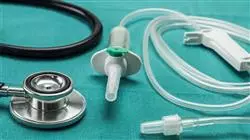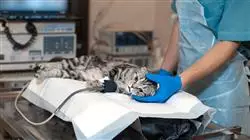University certificate
The world's largest faculty of veterinary medicine”
Introduction to the Program
Specialize in Veterinary Anesthesiology with this comprehensive online Professional master’s degree designed by elite veterinary sector professionals"

The objective of this complete program is to learn all the aspects of the intervention in Veterinary Anesthesiology, which we now present to you. With extensive methodological development, throughout this program you will be able to learn each and every one of the fundamental points in this area of work.
In this sense, the Professional master’s degree will begin with the phases prior to the application of anesthesia to the patient: knowledge of the equipment, previous management of the patient, medication and study of drug-drug interactions.
The study of the physiology most closely related to anesthesia, focusing on the involvement of the cardiovascular, respiratory, nervous and endocrine systems, will occupy the second part of the Professional master’s degree, an essential review to understand the functioning and consequences on the patient of the application of anesthesia.
However, the success of an anesthetic procedure goes far beyond the administration of the appropriate drugs. It is essential to master pre-anesthetic assessment, induction, maintenance and education in order to achieve success in the process and a return to normality without sequelae. Fluid therapy and even transfusion must also be taken into account and, therefore, will be covered in our complete program in Veterinary Anesthesiology.
The anesthesiologist must also take care of pain management. A basic vital sign that, if not adequately controlled, can be one of the main causes of delayed discharge and perioperative complications. Acquiring competence in this part of care is another of our major objectives.
Monitoring, anesthetic complications, management of anesthesia under special conditions and the application of balanced anesthesia and multimodal anesthesia protocols will also be covered in this highly scientifically rigorous program.
This Professional master’s degree is the opportunity you were waiting for to take your career to the next level and become a prestigious veterinarian”
This Professional master’s degree in Veterinary Anesthesiology contains the most complete and up-to-date program on the market. Its most notable features are:
- The latest technology in online teaching software
- Intensely visual teaching system, supported by graphic and schematic contents, easy to assimilate and understand
- Practical cases presented by practising experts
- State-of-the-art interactive video systems
- Teaching supported by telepractice
- Continuous updating and recycling systems
- Autonomous learning: full compatibility with other occupations
- Practical exercises for self-evaluation and learning verification
- Communication with the teacher and individual reflection work
- Availability of content from any fixed or portable device with internet connection
- Supplementary documentation banks that are permanently available, including after the program
You will learn about all aspects of Veterinary Anesthesiology from leading professionals with years of experience in the sector”
Our teaching staff is made up of professionals from different fields related to this specialty. In this way, we ensure that we provide you with the educational update we are aiming for. A multidisciplinary team of qualified and experienced professionals in different environments, who will develop the theoretical knowledge in an efficient way, but, above all, will contribute all the practical knowledge derived from their own experience; one of the differential qualities of this program.
This mastery of the subject is complemented by the effectiveness of the methodological design of this Professional master’s degree in Veterinary Anesthesiology. Developed by a multidisciplinary team of e-learning experts, it integrates the latest advances in educational technology. This way, you will be able to study with a range of comfortable and versatile multimedia tools that will give you the operability you need in your training.
The design of this program is based on Problem-Based Learning: an approach that conceives learning as a highly practical process. To achieve this remotely, we will use telepractice learning: with the help of an innovative interactive video system, and learning from an expert , you will be able to acquire the knowledge as if you were facing the scenario you are learning at that moment. A concept that will allow you to integrate and fix learning in a more realistic and permanent way.
This intensive program in Veterinary Anesthesiology will take you through different teaching approaches to allow you to learn in a dynamic and effective way"

This program represents a unique opportunity for professional growth due to the quality of the contents offered and the excellent teaching staff"
Why study at TECH?
TECH is the world’s largest online university. With an impressive catalog of more than 14,000 university programs available in 11 languages, it is positioned as a leader in employability, with a 99% job placement rate. In addition, it relies on an enormous faculty of more than 6,000 professors of the highest international renown.

Study at the world's largest online university and guarantee your professional success. The future starts at TECH”
The world’s best online university according to FORBES
The prestigious Forbes magazine, specialized in business and finance, has highlighted TECH as “the world's best online university” This is what they have recently stated in an article in their digital edition in which they echo the success story of this institution, “thanks to the academic offer it provides, the selection of its teaching staff, and an innovative learning method aimed at educating the professionals of the future”
A revolutionary study method, a cutting-edge faculty and a practical focus: the key to TECH's success.
The most complete study plans on the university scene
TECH offers the most complete study plans on the university scene, with syllabuses that cover fundamental concepts and, at the same time, the main scientific advances in their specific scientific areas. In addition, these programs are continuously being updated to guarantee students the academic vanguard and the most in-demand professional skills. In this way, the university's qualifications provide its graduates with a significant advantage to propel their careers to success.
TECH offers the most comprehensive and intensive study plans on the current university scene.
A world-class teaching staff
TECH's teaching staff is made up of more than 6,000 professors with the highest international recognition. Professors, researchers and top executives of multinational companies, including Isaiah Covington, performance coach of the Boston Celtics; Magda Romanska, principal investigator at Harvard MetaLAB; Ignacio Wistumba, chairman of the department of translational molecular pathology at MD Anderson Cancer Center; and D.W. Pine, creative director of TIME magazine, among others.
Internationally renowned experts, specialized in different branches of Health, Technology, Communication and Business, form part of the TECH faculty.
A unique learning method
TECH is the first university to use Relearning in all its programs. It is the best online learning methodology, accredited with international teaching quality certifications, provided by prestigious educational agencies. In addition, this disruptive educational model is complemented with the “Case Method”, thereby setting up a unique online teaching strategy. Innovative teaching resources are also implemented, including detailed videos, infographics and interactive summaries.
TECH combines Relearning and the Case Method in all its university programs to guarantee excellent theoretical and practical learning, studying whenever and wherever you want.
The world's largest online university
TECH is the world’s largest online university. We are the largest educational institution, with the best and widest online educational catalog, one hundred percent online and covering the vast majority of areas of knowledge. We offer a large selection of our own degrees and accredited online undergraduate and postgraduate degrees. In total, more than 14,000 university degrees, in eleven different languages, make us the largest educational largest in the world.
TECH has the world's most extensive catalog of academic and official programs, available in more than 11 languages.
Google Premier Partner
The American technology giant has awarded TECH the Google Google Premier Partner badge. This award, which is only available to 3% of the world's companies, highlights the efficient, flexible and tailored experience that this university provides to students. The recognition as a Google Premier Partner not only accredits the maximum rigor, performance and investment in TECH's digital infrastructures, but also places this university as one of the world's leading technology companies.
Google has positioned TECH in the top 3% of the world's most important technology companies by awarding it its Google Premier Partner badge.
The official online university of the NBA
TECH is the official online university of the NBA. Thanks to our agreement with the biggest league in basketball, we offer our students exclusive university programs, as well as a wide variety of educational resources focused on the business of the league and other areas of the sports industry. Each program is made up of a uniquely designed syllabus and features exceptional guest hosts: professionals with a distinguished sports background who will offer their expertise on the most relevant topics.
TECH has been selected by the NBA, the world's top basketball league, as its official online university.
The top-rated university by its students
Students have positioned TECH as the world's top-rated university on the main review websites, with a highest rating of 4.9 out of 5, obtained from more than 1,000 reviews. These results consolidate TECH as the benchmark university institution at an international level, reflecting the excellence and positive impact of its educational model.” reflecting the excellence and positive impact of its educational model.”
TECH is the world’s top-rated university by its students.
Leaders in employability
TECH has managed to become the leading university in employability. 99% of its students obtain jobs in the academic field they have studied, within one year of completing any of the university's programs. A similar number achieve immediate career enhancement. All this thanks to a study methodology that bases its effectiveness on the acquisition of practical skills, which are absolutely necessary for professional development.
99% of TECH graduates find a job within a year of completing their studies.
Professional Master's Degree in Veterinary Anesthesiology in Major Species</h1
Part of the success in surgical procedures in the veterinary field is linked to a correct anesthesia and adjuvant monitoring. This does not seem to mean major inconvenience when we talk about conventional pets: canines, felines or birds, but before other species of considerable size such as equines, camelids, swine or ruminants, expectations require new strategies and skills. For this reason, TECH Global University presents the Professional Master's Degree in Veterinary Anesthesiology in Major Species, a resizing of the clinical animal panorama in its most particular aspects, from the physiology of the cardiovascular system in the horse to the application of euthanasia protocols. Do you want to deepen your knowledge in the use of ketamine and lidocaine, learn how to accompany a laparoscopy or master intubation techniques for large and small camelids? In this postgraduate course you will find this and much more. Thanks to our methodology of 100% virtual classes combined with innovative educational models, not only will you be able to graduate without leaving home, but you will do it regulating your own schedule and accompanied by an extraordinary faculty. TECH is everything you were looking for.
Specialize in anesthesiology for larger species
Whether in minimally invasive procedures or in surgeries of complex intervention, anesthesia must always go through three phases: before, during, after, plus a fourth one that encompasses the perioperative complications present in the course of the surgical work. The latter are avoidable with an optimal assessment of the patient's nociceptive condition, the correct choice of anesthetic and analgesic drugs and, of course, constant monitoring to avoid arrhythmias, hypoxemia, hypercapnia, among others. Thanks to our comprehensive Professional Master's Degree, you will acquire sufficient skills to carry out an optimal anesthetic control of the animal. There are a total of ten modules in which you will learn sedation, analgesia, locoregional anesthesia, cardiopulmonary resuscitation, fluid therapy, special clinical situations, among other useful topics. At TECH we take professional training to another level, using the best educational technology and the most qualified teaching teams, which is why we are ranked as the best online university in the world. Enroll now and be part of a unique experience.







